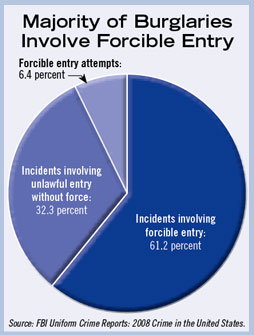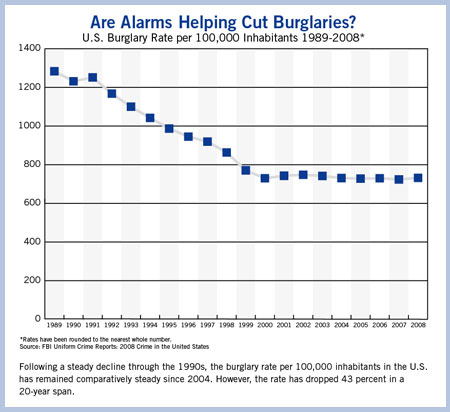
Interestingly, the largest increase in residential burglaries was those that occurred during the day. Daytime burglaries of residences jumped 8.3 percent, up to 805,193 from 738,654 in 2007. In comparison, residences were burglarized 437,007 times at night in 2008, an increase of just 3.5 percent from 2007.

“During the day, it may be easier to see, but it’s also easier for the burglar to identify a target. No car in the driveway; ring the doorbell and no one answers. They may even have a phone number and try to call,” Fox added. “If they get the answering machine that says no one’s available, their first thought isn’t going to be that someone might just be in the bathroom.”

Fox also suggested that people might not to set the alarm during the day. He said many are more likely to activate an alarm at night to prevent burglary or an attack, but in the daytime they may be too rushed or too indifferent to activate it.
“We know that homes that are protected (by a security system) are much less likely to be broken into than a home that doesn’t have any visible sign of a security-type system,” said Jon Sargent, past president of the California Alarm Association and ADT Western industry relations. “I think homes with other forms of protection, even something as simple as a dog or some indication that they have some type of camera system, they’re less likely [to be targeted].”
Not all of the news from the report was bad, however. Burglaries of nonresidential buildings such as stores and offices fell 5.9 percent from 2007 to 2008. Daytime incidents were down 2 percent, while nighttime burglaries fell 6 percent; the five-year trend in nighttime burglaries fell more than 10 percent.
“Security measures in a commercial establishment may seem better than what people have in their homes, as perceived by the burglar,” Fox said. “It may be that the commercial establishment has better resources, or may put greater resources into it — whether it be a guard service or an alarm system — than a private residence does.” Fox added that, as the economy has struggled, residents may have chosen to cut back on their alarm systems.
The advancements in technology — and perhaps of more significance, the lowering of their cost — are at play in the decline of nonresidential burglaries, Sargent said. The affordability and ease of use of electronic protection systems has encouraged many users to add security systems to protect their properties.
“The proliferation and the advancement of camera systems, both with monitoring capabilities and others that are simply recording, could be playing a factor in that,” Sargent said. “People understand that there are more cameras everywhere these days.”
As for stolen property, not surprisingly, locally stolen motor vehicles topped the list. Jewelry and precious metals were next (excluding miscellaneous items at almost $3.8 billion) at $1.5 billion stolen, 4.3 percent recovered; followed by currency at nearly $1.2 billion stolen, 3.5 percent recovered.
The value of other common goods stolen: electronics — televisions, stereos, etc. — office equipment, and household goods totaled almost $2.2 billion.
